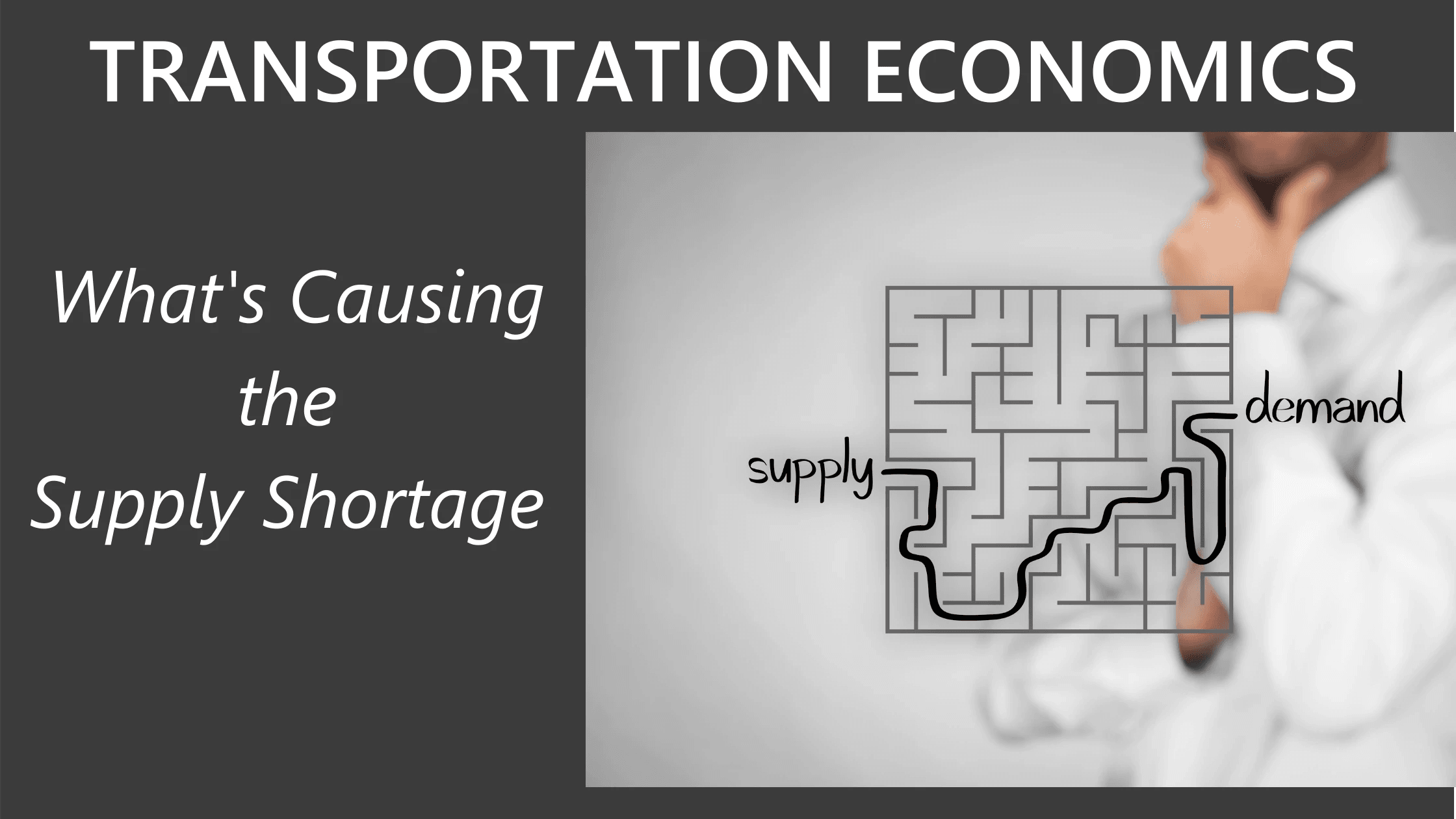

Economics seems so easy…supply and demand. As demand goes up, supply reacts accordingly – either supply remains unchanged, but higher prices and longer waits satisfy the demand or increase the supply to satisfy the demand while keeping prices unchanged. But like most things in life, there are many layers to peel back to understand the reasoning behind supply and demand changes.
Markets are hardly at a state of equilibrium for very long, and the rest of it is reacting and catching up to what’s causing an imbalance one way or the other. And if we take a close snapshot at the supply and demand state of transportation today, it sheds better light on what to expect in both the near and long term.
Many people are quick to blame everything on COVID-19, and that would be the easy thing to do. But the global pandemic just accelerated what was already approaching in our industry. There are things past, present, and future that are causing a major imbalance in supply and demand.
Over the course of the past few years, capacity for non-dedicated freight was already drastically down. Dedicated freight allows for more predictability and more regular home time and requires less skill to perform. Also, carriers with over 100 trucks makeup about 1% of the overall carrier count but are nearly 75% of tractors’ total market capacity.
The ‘mega-fleets’ are moving more and more toward a dedicated and/or asset-light model. The downside is that it leaves just 25% of market capacity, but it does still leave 99% of the carriers out there.
But here’s the thing with the fleets that are less than 100 tractors – their cost of doing business is higher. This is especially true when it comes to insurance costs. Nuclear verdicts have caused insurance rates to skyrocket, and Y/Y increases of 12% that were seen as very high in 2018 are now becoming closer to 20% – 30%. This is a difficult pill to swallow for small fleets, often seen as not worth the risk, and is one of the top reasons these fleets leave the market.
The pool of available drivers is also a major factor. Keep in mind the new wave of reinforcements for an already older workforce (average age is around 53 years old) is being filled mostly by students. These students are obviously less experienced, new to the job and lifestyle that comes with driving a truck and expect to make a good living.
But for so long, transportation has been viewed as a commodity and thus treated as such both by carriers and the ones paying to move the freight. Then add the drug and alcohol clearinghouse, a lack of women (47% of labor market but only 6% of truck drivers) that are employed in the industry, and an overall lack of respect shown truck drivers, and it adds up to a less than desirable career choice.
COVID-19 was just an accelerant to what was already happening but maybe not visible yet. In March, we started seeing sports get canceled, schools close, and then many statewide essential business only orders come in to attempt to slow the spread of the virus. With a decrease in available freight, many shippers conducted mini-RFPs to secure cheaper transportation that has done much more harm than good as quickly as the market rebounded. Because by Memorial Day, most states really had eased back on their restrictions or ‘lockdowns,’ and summer officially kicked off. Demand for goods soared as people shifted their spending habits to goods rather than experiences (concerts, travel, etc.). As we are now rolling into the end of the year, this could be a trend that continues as more restrictions may be on the horizon. Overall outbound freight volumes have risen over 1.5x 2019 levels, and the available capacity to move those volumes has been going down.
During those times, truck drivers were finally seen as the essential workers they are, finally viewed as more than just a commodity. The long-term effects of this will result in higher pay, better facilities to send into and out of, better equipment, and more consistent home time. And on top of that, there are just fewer of them available to fill open positions. There are two major reasons behind this.
The first is the older workforce means they are generally more susceptible to complications from COVID-19, and many of them decided the risk just wasn’t worth it. The second reason is that truck-driving schools were all but shut down during those restrictions and are just now getting back to close to 75% capacity. This is projected to result in a 200,000 driver shortage compared to last year. Early projections are that 15%-20% wage increases will be necessary to fill the current gap.
The future also has some things worth mentioning that are going to affect overall supply as well. Most people who want to work are working again – pre-pandemic. We were already fighting another supply/demand battle with the overall labor market, which was hovering at about 1 million more jobs than people looking for work in February 2020. So truck driving needs to quickly become a more attractive career choice, or the minimum age requirement (currently 21 for interstate) needs to be reduced to increase the available labor pool.
Also, customer requirements are becoming more stringent by the day. Not that it’s a bad thing – customers should get what they pay for, but things like weather, traffic, accidents, etc., do happen, and being punished makes not only certain freight but truck driving as a career seem less desirable. Lastly, things like digital freight marketplaces are great innovations in technology, but it’s not providing more capacity – it’s simply making existing capacity fight with itself more than it has. Long-term effects of the freight tech boom should prove beneficial and drive out wasteful activity and unnecessary costs, but simply buying market share is unsustainable.
What does it all mean? If we’ve learned anything from COVID-19, it’s that truck driving is an essential service that keeps America moving and keeps those shelves stocked at the stores we all shop. Rates have to go up to meet demand in both the short-term and the long-term. Securing capacity with safe and reputable providers will come at a price but will allow goods to be on the shelves when needed.
Long-term, the economic scale’s supply-side also has to increase – higher wages, more attractive equipment, more home time, and other creature comforts previously mentioned above. The good news is the last 2 months have seen robust Class 8 truck orders, a signal that supply is coming – but that supply also comes at a cost, and it will be a higher cost than what’s been thought of as commoditized in the past. The net result is inevitably an increase in transportation costs across the board. Those who are quicker to accept it, budget accordingly, and secure necessary capacity will keep their goods moving much easier than those who are slower to react.